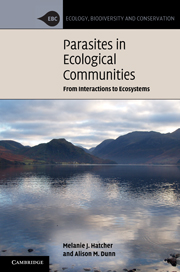Book contents
- Frontmatter
- Contents
- Acknowledgements
- List of abbreviations
- 1 Introduction
- 2 Parasites and competitors
- 3 Parasites and predators
- 4 Parasites and intraguild predation
- 5 Plant pathogens and parasitic plants
- 6 Parasites and invasions
- 7 Ecosystem parasitology
- 8 Emerging diseases in humans and wildlife
- 9 Where do we go from here?
- References
- Index
8 - Emerging diseases in humans and wildlife
Published online by Cambridge University Press: 05 August 2012
- Frontmatter
- Contents
- Acknowledgements
- List of abbreviations
- 1 Introduction
- 2 Parasites and competitors
- 3 Parasites and predators
- 4 Parasites and intraguild predation
- 5 Plant pathogens and parasitic plants
- 6 Parasites and invasions
- 7 Ecosystem parasitology
- 8 Emerging diseases in humans and wildlife
- 9 Where do we go from here?
- References
- Index
Summary
Introduction
Emerging infectious diseases (EIDs) such as human immunodeficiency virus (HIV), severe acute respiratory syndrome (SARS), malaria and bovine tuberculosis have significant social and economic costs, threatening human health, wildlife conservation, biodiversity and sustainable agriculture. An EID can be broadly defined as a disease that is increasing in range, incidence or impact. This inevitably means that there is some contingency in deciding what classifies as an EID. Pathogens may be classed as emerging for a number of reasons:
(1) increasing incidence of infection in a host population;
(2) increasing severity of infection (virulence) in a host population;
(3) spread to novel populations;
(4) spread to novel species;
(5) a recently evolved novel pathogen or strain, including drug-resistant strains.
Some researchers confine their definitions to a subset of these processes – for instance, Woolhouse et al. (2005) are generally concerned only with categories 4 and 5 above, whereas others (Ostfeld et al., 2005; MacDonald & Laurenson, 2006) take a broader view. The term ‘re-emergence’ is sometimes used with reference to long-established infectious diseases, such as malaria and bovine tuberculosis, which are increasing in incidence. Partly resulting from differences in classification, estimates for the number of EIDs vary. Childs et al. (2007b) suggest a rule of thumb of about 30 zoonotic human EIDs in the last 30 years, whereas Jones et al. (2008) identify 335 human EID first records between 1940 and 2004; this latter study includes many novel antibiotic-resistant strains of bacteria and novel opportunistic infections associated with the pandemic spread of HIV and AIDS.
- Type
- Chapter
- Information
- Parasites in Ecological CommunitiesFrom Interactions to Ecosystems, pp. 320 - 385Publisher: Cambridge University PressPrint publication year: 2011



